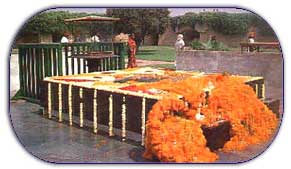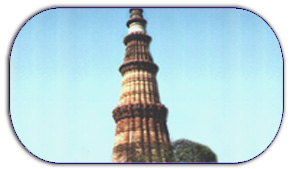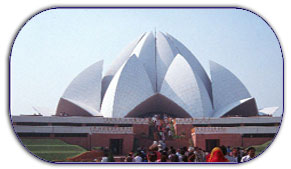The Bahai Temple
Completed in 1986,the Bahai temple is set amidst pools and gardens. Adherents of any faith are free to visit the temple and pray or meditate silently according to their own religion . The structure is in lotus shape so it often called the lotus temple. The view of the temple is spectacular before dusk when the temple is floodlit.

ISKCON Temple
Built by the Hare Rama Hare Krishna cult followers this temple is dedicated to the Lord Krishna. Built on a hillock, this complex is elegantly built and is one of the largest temple complexes in India.
Completed in 1986,the Bahai temple is set amidst pools and gardens. Adherents of any faith are free to visit the temple and pray or meditate silently according to their own religion . The structure is in lotus shape so it often called the lotus temple. The view of the temple is spectacular before dusk when the temple is floodlit.

ISKCON Temple
Built by the Hare Rama Hare Krishna cult followers this temple is dedicated to the Lord Krishna. Built on a hillock, this complex is elegantly built and is one of the largest temple complexes in India.

Laxmi Narain Temple
One of Delhi's major temples and a major tourist attraction. Built by the industrialist G. D. Birla in 1938, this beautiful temple is located in the west of Connaught Place. The temple is dedicated to Laxmi, the goddess of prosperity and good fortune. The temple has well grafted gardens. Popularly known as the Birla Mandir.

Red Fort
Built in 1648, this sprawling fort of red sand stones along the river Yamuna is surrounded by a wall of about 2.4 km in circumference. It was built by the Mughal emperor Shah Jahan. after he transferred his capital from Agra to Delhi. The fort has two main entrances, the Delhi Gate and the Lahori Gate facing the famed Chandni Chowk market. The Fort has Diwan-e-Aam, and Diwan-e-Khas where the king would grant audience to the public and would grant audience to important people respectively Adjacent to this is the Rang Mahal, the water cooled Apartment for the royal ladies. A Light and Sound show is held in the evening.

India Gate
Flanked by ornamental ponds and lawns, Rajpath is host to the Republic Day Parade. The two secretariat buildings and Rashtrapati Bhawan on the Raisina hills are located on the two sides of this immensely broad road. Previously the Boat Club, besides the Rajpath, was host to many demonstrations and Rallies. India Gate is towards the eastern end of Rajpath.

Qutub Minar
The Qutub Minar made of red sandstone rising to the height of 72.5mts is an architectural marvel of the 13th century. Also a must is the visit to Ashoka Pillar dating back to the 5th century. Though made of iron it has with stood the weathers of time.A very interesting belief is assigned to this pillar- Stand with your back to the pillar, and if you can hold your hands around it, then make a wish and it will surely come true.
 Jama Masjid
Jama Masjid JamaMasjid is one of biggest mosques in India-A magnificent architectural gift by emperor Shah Jahan. Completed in 1658, this mosque has three gateways, four angle towers and two minarets. You can enter the mosque but take precaution to take off your shoes and make sure that you are properly dressed before entering . One can also go to the top of minarets. From here you can have a birds eye view of Delhi.
 Nizam-ud-Din Shrine
Nizam-ud-Din Shrine It's one of Delhi's major attractions. It's the tomb of the famous Sufi saint Nizam-ud-Din Auliya. Inside the premises of the shrine is a tank which is surrounded by many other historically significant tombs. The shrine also has the tomb of Amir Khusru and the grave of princess Jahanara, the daughter of Emperor Shah Jahan. It is worth visiting the shrine at around sunset on Thursdays, as it is a popular time for worship, and Qawwali singers start performing after the evening prayers.
For further information on the places to visit in Delhi and how to get there, please visit the official website of Delhi Tourism Department.
www.delhiplaces.comHere is a list of places you could visit in Delhi other than the ones mentioned above:
Old Fort
Jantar Mantar
Humanyun's Tomb
Safdarjung Tomb
Chhatarpur Temple
Raj Ghat
Gurudwara Rakab Ganj
Gurudwara Bangia Sahib
source: tourism places in delhi {www.delhiplaces.com}















